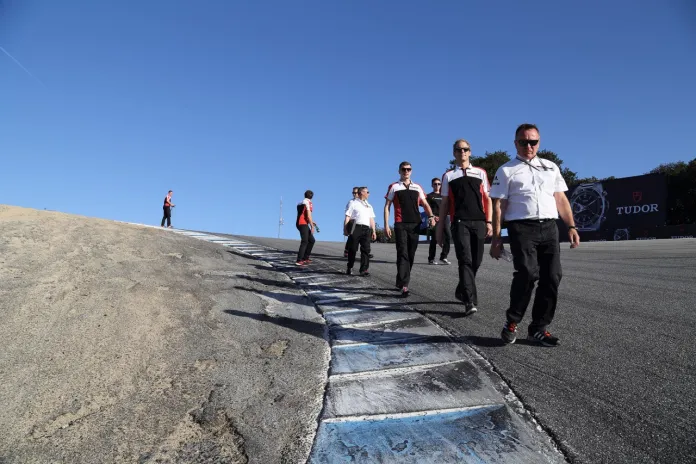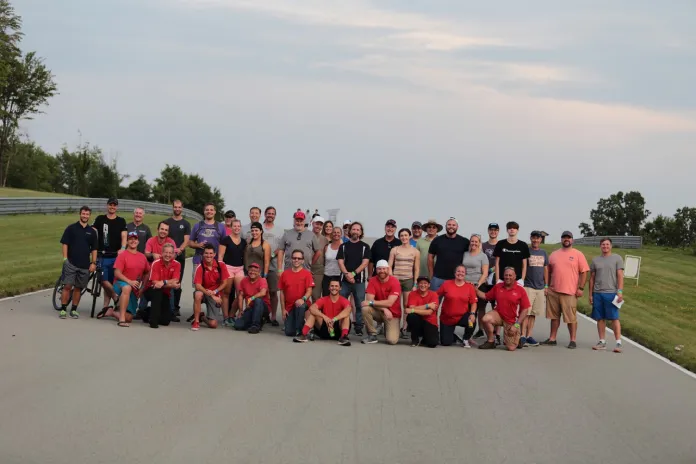Track walks are a time-honored practice drivers use to better understand the nuance of a track, ultimately to achieve faster lap times. Track walks usually come on a Saturday evening, after a long day of racing. You’re always tired, and they do require extra initiative, but they’re nearly always revealing if you know how to do them properly.
If you’re like a lot of drivers who go on a track walk, you might not know what you’re looking for other than to look for something — anything — to help you find your way through each turn more quickly.
We tagged along on a track walk at Pittsburgh International Race Complex last summer with renowned “Speed Secrets” author, racecar driver and coach Ross Bentley, NASA Great Lakes chief instructor Eric Meyer and a gaggle of instructors racers and TT competitors. We wanted to know what Bentley looked for on a track walk, how he approached them, and as we walked along, we also took note of Meyer’s techniques to help drivers.

We also caught up with Blayze.io coach Dion Von Moltke and asked him how he handles a track walk, what he looks for, what he hopes to accomplish and why he does what he does.

Bentley said he’s a big fan of doing track walks after he’s driven the track. That way you’ve got a feel for the track. Driving it raises questions about a given area on the track. Walking it hopefully answers them.
“You drive the track and then you go on the track and you walk it and you go, ‘Oh, that’s why it feels the way it does here. And that’s why I’ve got grip here. And I have less grip here,’” Bentley said. “Sometimes in the car at speed, you just can’t notice some things, and I’m a big believer in the driver that has the most reference points wins.”

Bentley said the more reference points you have, the sooner you can recognize you’ve made a mistake and therefore you can start to make adjustments for that mistake earlier, so you can manage it.
“So, I look at a guy like Lewis Hamilton and go, ‘He has so many more reference points for a track than the drivers here, right?’” Bentley said. “He just soaks those things up and that gives him an advantage from that perspective. If you’re a racer, for sure it just makes you more consistent and able to deal with problems better because you’ve got more references.”
As we walked the PittRace track — backward, mind you — Meyer would stop at different points along the way and ask the students, drivers and instructors about how they would take a certain turn, where they’d turn in, how much curbing they’d use, and whether those curbs are usable in the wet. By getting drivers to speak up, they become part of the lesson, highlighting things other drivers might not see or think of, and by hearing counter points and other theories. It mirrors the dialectic approach used in classical philosophy.
The backward approach Meyer used when leading his track walk dovetails with Von Moltke’s fundamental breakdown of the five reference points of every corner: Exit apex, apex, slow point of the corner, turn-in point and braking point.
“You work every corner backward,” Von Moltke said. “Where you exit changes where you apex. Where you apex changes where you have the slow point of the corner. Where your slow point and apex is changes your turn-in point. Where your turn-in point is changes your braking point. So you sort of work backward.”
Bentley prefers to do track walks by himself unless it’s for group instruction like at PittRace. On the walk, he takes on the observant nature of a golfer on a green. He squats, looks at turns backward and forward and takes note of subtle changes in camber and track surface that can affect how a car gets through a corner. But that’s not all, and what he said next made a lot of sense.
“I also like to look at which of the corners are going to be more forgiving for me to try things. As I’m walking around and I go, ‘You know, if I go off here, that’s going to hurt. If I go off over there, I can get away with it,’” Bentley said. “So that’s where I’m going to push a little bit harder and test things a little bit more so. Even to the point of looking at it like, ‘If I go off here, what am I going to do?’ And I don’t like to dwell on that part of it, but I do like to be prepared.”
Group track walks can be a bit distracting, especially where the dialectic runs amok or lacks focus. Or too many beers. Von Moltke said it almost would be better to use a rental car and take small groups and do a slow lap, stopping after the turns to get out and analyze a given corner. Most tracks don’t allow motorized vehicles on the racing surface after the track is cold, regardless of what you’re doing or how slowly you’re driving. That would really come in handy at a long track like Road America, but motorized vehicles aren’t allowed after hours, so to speak. That’s a 4-mile track walk.
“Group track walks are extremely difficult to do, right?” Von Moltke said. “To be honest with you, I’ve never come off of one and been like, man, we nailed that, but it can be fun. It can be engaging.”
If you can get away with a bicycle or a golf cart, those also can be helpful. Slight uphill sections can be easier to detect on a bicycle or if you can hear the golf car groan a bit under load. They also allow you to do a few more laps than you would by walking, and can help with visualization and rhythm. It might seem odd, but driving it at 5 or 10 mph does help.
Von Moltke’s approach varies with a few factors, including whether he’s there as a driver, whether it’s his first time there, in a new car or whether it’s a track he knows relatively well. If he’s driven the track, he’s focused on where he is having issues, where the problem areas are, a push here, oversteer there. Taking the engineers with him gives them a better idea of the track dynamics.
“Most of the time, it’s more about us walking with our engineers and talking to our engineers,” Von Moltke said. “It’s typically about where are we struggling, where our problem areas are. It lets the engineers get a little bit better picture or idea of what’s happening, what the track dynamics are.”

If you’re lucky enough to have an engineer on your race team, you are probably lucky enough. If you’re like a lot of NASA competitors, the driver is the engineer, who also is the crew chief, mechanic, transport driver and cook. When it comes time to do a track walk, you’re either out there by yourself or with friends and fellow racers.
If you go by yourself, the good news is that you can really focus, and the goal of this story is to provide you with what you need to focus on. Braking points. What gear will you be in? Where do you get back on the gas? Is there any camber at apex? Are there patches or seam sealer that will add or subtract grip? Are the curbs usable? Are they usable in the wet? Bentley talked about reference points. If it’s a new track, you’re going to have to absorb a lot of them. If it’s a track you know and love, you need to look for newer and more subtle clues. Von Moltke echoed Bentley’s points almost verbatim.

“I’m looking at those reference points. I’m trying to get an idea of what’s this going to look like behind the car? I’m looking at where the rubber is, right? So I’m looking at where the rubber starts on these exit curbs?” Von Moltke said. “Are there any obvious divots and things that I might want to avoid. You can kind of look at the backside of curbs, look at curbs and sort of see, ‘Oh, that’s going to hold a lot of rain water, or that looks really sharp, or that’s a big drop. I want to avoid that. So you’re just looking for more of the details and reference points.”
Another element to a track walk that Von Moltke and Bentley said they do every time is to drag the bottom of their feet along the racing surface to test its grip. Obviously, sneakers are different from racing tires, but scuffing feet is telling enough that both of them do it. While you’re at it, test the grip online and offline. Look at the aggregate that makes up the asphalt. If it’s wet the next day, where’s the aggregate that’s going to let your car stick in the rain?
“I like to rub my foot on the track surface when I’m going along, and just sometimes you can just kind of go, ‘OK, this is going to be a little more grippy than that part over there,’” Bentley said.

During a track walk at what was then Mazda Raceway Laguna Seca, drivers in the Mazda Race of NASA Champions in 2015 found that the painted curbs were so sticky with rubber from the Tudor and Continental Challenge cars that your sneaker actually stuck to them when you stepped on them. A track walk is about becoming one with the track.
“And the last part of a track walk to me is, I know this sounds a little woo-woo, but I get to connect with the track,” Bentley said. “But it’s also fun to go and do it with a group of drivers and share the process.”

Getting the most from a track walk means having a plan to focus on what’s important. Von Moltke summed it up this way.
“Now, a lot of that comes down to knowing what to look for. I find 90 percent of the time in grassroots racing, you’ll hear drivers say things like, ‘Well, I know what I need to do to go faster. I just need to go out there and do it,’” Von Moltke said. “To be completely candid with you, pretty much a hundred percent of the time they’re actually not quite right. Or they’re out of order. A key part of going faster in our sport is having the right order of things of what to do next. So their situation might be out of order. So, if you don’t have a plan and you don’t know what to look for, you kind of walk a track aimlessly and you’re not getting anything out of it. So when you’ve got that plan, when you’ve got that coach kind of working with you and giving you the things that we’re doing, then you’re using the track walk to visualize, to see it, to get the sight pictures. And then it becomes very helpful. But if you don’t have the whole picture, you could easily waste your time and energy.”











